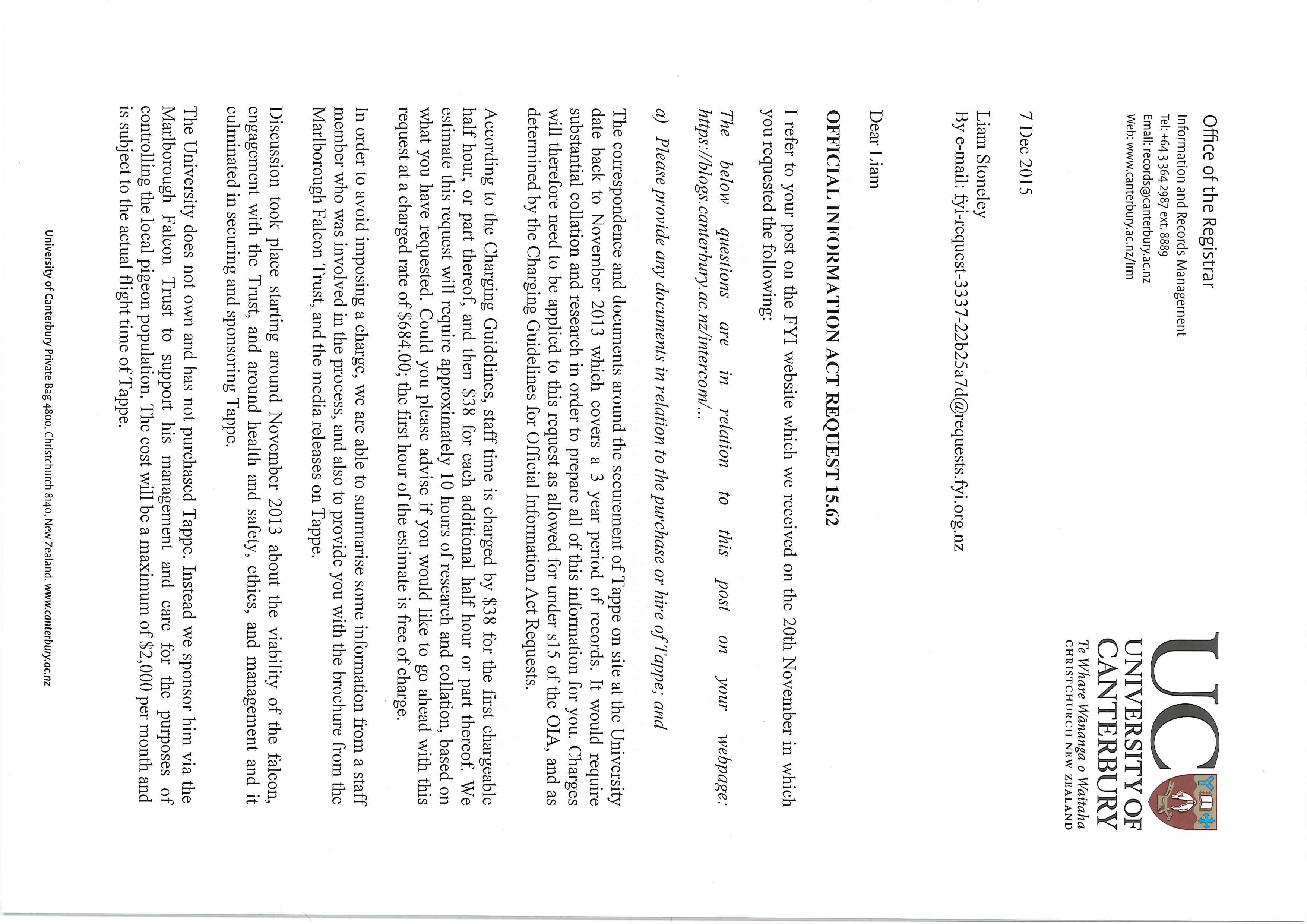
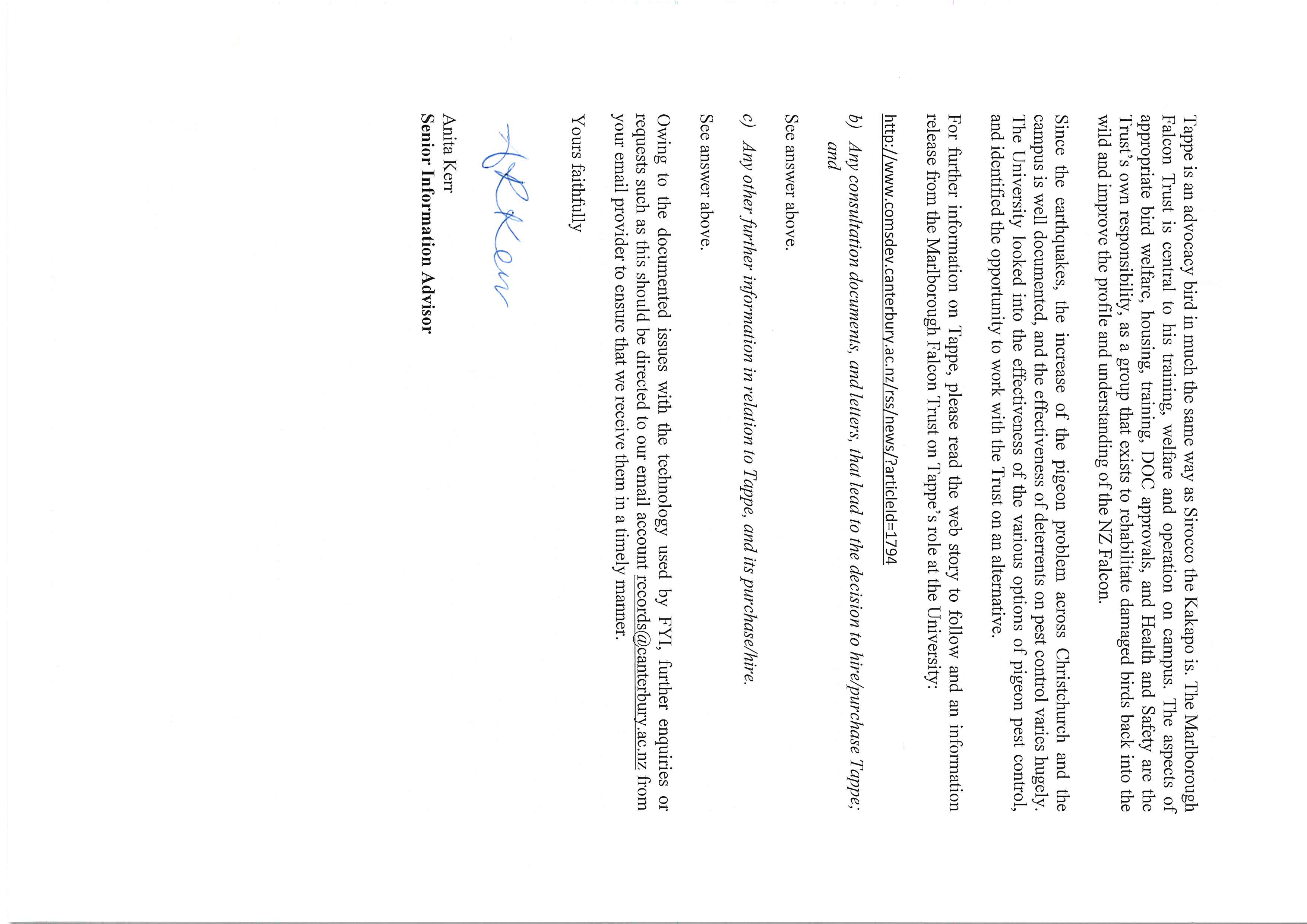

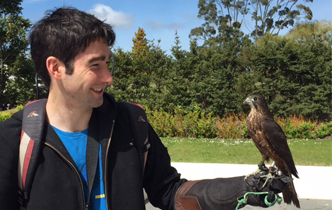
11/30/2015
UC News University of Canterbury New Zealand
Frequent falcon flights to
prevent problem pigeons
Communications
6 November 2015
The University of
Canterbury will fly a native
New Zealand falcon (kārearea) above its Ilam
campus to naturally deter pest birds, the first
time a University has adopted such a tactic.
Marlborough Falcon Trust handlers Vikki Smith
and Rob Lawry will begin freeflying a specially
bred oneyearold kārearea – as featured on the
$20 banknote – to help reduce UC’s pigeon
Falconer Rob Lawry and kārearea Tappe will help deter UC's
population. Tappe, named for Mount Tapuaeo
pigeon problem.
Uenuku, was bred by the Trust from injured
captive falcons unable to survive in the wild.
UC is taking this positive action to address the problematic presence of large numbers of pigeons in a natural way
that also supports a rare native bird species.
Tappe has been trained to complete territorial flights around the campus to scare flocks of pigeons from the
University’s buildings and away from the campus.
UC students and staff will be treated to regular falconflying displays as Tappe patrols his territory. Seeing a
kārearea flying regularly at UC will also be an opportunity to raise awareness of the plight of New Zealand falcons.
Kārearea are rare, with only an estimated 6000 birds left. Their habit of sitting on high perches looking for prey
makes them difficult to spot in the wild, and there are very few places in New Zealand that display native falcons.
Kārearea are one of New Zealand’s most spectacular native birds, extremely fast and agile. Prior to human arrival in
New Zealand, almost all of their natural diet was birds. Thepesence of birds such as kārearea scares potential prey
birds and they leave the area.
Kārearea are a natural predator to pigeons. The pigeon’s innate predator defence is avoidance and escape. The
presence of large flocks of pest birds, such as pigeons leads to problems from their large volumes of droppings.
Where pigeon numbers are high, buildings and paths are defaced and deteriorate more rapidly, and the spread of
disease increases.
Birds of prey are used around the world for bird control, particularly around airports. These birds are trained to fly to
a lure, rather than capture birds. This predatorprey relationship is a completely natural way of discouraging the
presence of unwanted birds.
UC falcon research and conservation
The University of Canterbury has a history of research into kārearea.
http://www.comsdev.canterbury.ac.nz/rss/news/?articleId=1794
1/2
11/30/2015
UC News University of Canterbury New Zealand
Nick Fox obtained his PhD from UC in 1977 with his detailed study of kārearea in Marlborough. In addition to his
thesis, Fox wrote a number of papers relating to falcons, including one on the distribution of kārearea and an
estimate of numbers of breeding pairs. Fox established the Falcons for Grapes project in 2005. This programme
reintroduced falcons to the Wairau Plains of Marlborough.
UC researcher Sara Kross studied many aspects relating to this relocation of falcons, earning her PhD from UC in
2012 as well as publishing a number of scientific articles. She found that the country’s only remaining endemic bird
of prey is a perfect match for vineyard pest control. Kross is an advisor to the Marlborough Falcon Trust (MFT).
Introducing Tappe
Hatched in an incubator along with his two siblings, Tappe is the chick of two Marlborough falcons. Both Tappe’s
sibling chicks were released in January 2015. Tappe’s father, Napoleon, is blind in one eye and his mother, Sara,
has survived a broken tail and damage to her cere (the fleshy skin above the beak). Neither of this breeding pair
could survive in the wild. Together, however, they have successfully bred for the past three years that the MFT
breeding programme has been operational.
As a chick, Tappe showed early promise and was surprisingly comfortable around humans. At two months old, he
began his training as an advocacy falcon to assist with MFT’s educational goals. Tappe relocated to Canterbury in
September 2015 and commenced training with his handlers, Vikki Smith, a UKtrained falconer, and Rob Lawry, who
has a Master’s degree in Biochemistry from the University of Canterbury.
For further information please contact:
Margaret Agnew
Senior External Relations Advisor
Communications and Engagement
University of Canterbury
Ph: (03) 364 2775
Mobile: 027 5030 168
[email address]
Or
Andy Frost, Marlborough Falcon Trust
Cell: 027 476 3118
andy.frost@pernodricard.com
http://www.comsdev.canterbury.ac.nz/rss/news/?articleId=1794
2/2
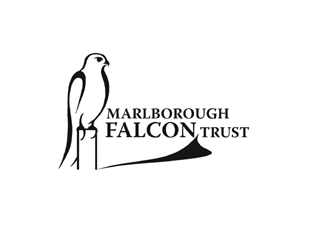 Marlborough Falcon Trust.
Marlborough Falcon Trust.
Captive-bred native falcon begins new job at University of Canterbury.
Marlborough Falcon Trust handler Vikki Smith will begin free flying 1-year-old New Zealand falcon,
Tappe, in an attempt to curtail the University of Canterbury’s pigeon problem. Should this innovative new
pest-control strategy be successful, it will be the first of its kind in New Zealand.
Tappe, named for Mount Tapuae-o-Uenuku has been trained to complete territorial flights around the
campus with the intention of scaring off the local pigeons. Renowned for incredibly fast flying with high
manoeuvrability on the wing, New Zealand falcon (kārearea) are a natural predator to pigeons, which are
an introduced species. University of Cantebrury (UC) students will be treated to regular flying displays
as Tappe patrols his territory.
Tappe’s presence will have a deterrent effect on the pest bird population residing at UC. The pigeon’s
innate predator defence is avoidance and escape. It is this natural response that the Marlborough Falcon
Trust (MFT) is hoping will assist UC to curb this destructive pest.
Tappe is the chick of two Marlborough falcons hatched in an incubator along with his two siblings. Both
sibling chicks were released in January 2015. Father, Napoleon is blind in one eye and mother Sara has
survived a broken tail and damage to her cere (fleshy skin above the beak). Neither could survive in a
wild environment again, together however they have successfully bred for the past 3 years that the MFT
breeding programme has been operational.
Tappe showed early promise and was surprisingly comfortable around humans and at 2 months began his
training as an advocacy falcon to assist with Marlborough Falcon Trust’s educational goals. Tappe
relocated to Canterbury in September 2015 and commenced training with his new handler Vikki Smith, a
UK-trained falconer.
The Marlborough Falcon Trust
A locally run charitable trust dedicated to the conservation of the New Zealand falcon (kārearea), our last
remaining endemic raptor. This special bird is featured on the NZ $20 note.
In 2009 wild numbers were estimated to be just 6000 individuals when esteemed ornithologist Dr Nick
Fox of International Wildlife Recovery established the Falcons for Grapes (FFG) programme on the
Wairau Plains. The programme aimed to secure a future for the falcon by successfully integrating the
birds with the winegrowing industry that had exploded onto Marlborough’s landscape. A symbiotic
relationship was sought with the falcons hunting within the pest bird population that is responsible for
millions of dollars’ worth of damage to crops every year. Wild chicks were re-located to vineyards.
Sadly, many falcon fatalities occurred due to predation, electrocution and human persecution and the
programme was eventually halted in August 2011.
At this time the Marlborough Falcon Trust agreed to take over the stewardship of 7 permanently injured
falcons and continue to support landowners who had acquired falcons through the FFG programme with
expertise and food supplements.
PO Box 566 |Blenheim 7240, Marlborough | New Zealand
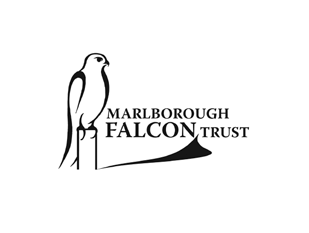
Our single goal of a thriving falcon population is being realised through a number of innovative avenues.
1. Education and Advocacy.
Our aviary manager attends many community events and schools with our trained advocacy
falcon Fern, speaking of the small significant changes we all can make to ensure the future of this
species while giving New Zealanders the unique opportunity to observe a live falcon in close
proximity.
2. Rehabilitation and Release
The MFT has built a reputation that ensures when a member of the public encounters an injured
falcon or an abandoned nest with eggs or chicks we are able to collect, hatch, rear or rehabilitate
for release
3. Captive Breeding
Utilising our permanently injured falcons we have accomplished 3 successful breeding seasons.
2013 saw 2 chicks released, 2014 saw 6 chicks released and we currently have 3 chicks and 7
eggs at our breeding aviary on Brancott Estate.
We see the partnership between the UC and MFT as a valuable step in the conservation of this iconic
species. Peregrine falcons have successfully integrated into modern cities the world over, seeing kārearea
in a city environment is an opportunity to raise awareness of the need for conservation of this superb,
threatened New Zealand bird.
PO Box 566 |Blenheim 7240, Marlborough | New Zealand
 Marlborough Falcon Trust.
Marlborough Falcon Trust.
Captive bred native falcon begins new job at University of Canterbury.
Additional notes
UoC Reducing pigeon impact by using a natural method of discouraging pigeon presence
The presence of domestic pigeons in cities leads to problems from their droppings. Defacing and
accelerated deterioration of buildings, manure deposited and the spread of diseases occur where pigeon
numbers are high. Pigeons are numerous international y, and introduced to New Zealand. The University
of Canterbury, like many building complexes has a maintenance issue caused by the presence of large
numbers of pigeons.
Kārearea are one of New Zealand’s most spectacular endemic birds, extremely fast and agile. Prior to
human arrival in New Zealand, almost all of their natural diet was birds. The presence of raptors scares
potential prey birds and they leave the area. Raptors are used around the world for bird control,
particularly around airports and refuse disposal sites. The birds are trained to fly to the lure, rather than
capture birds. This predator-prey relationship is a completely natural way of discouraging the presence
of unwanted birds in a locality.
UoC Visibility of kārearea so students, staff public can see flying – advocacy
Kārearea are rare, estimated to be about 6000 individuals left. Their habit of sitting on high perches
waiting patiently for prey makes them difficult to see in the wild, and there are very few places in New
Zealand that falcons are on display. Having kārearea in an urban environment is one way of making
people aware of the species and having birds flying, instead of displaying in pens, illustrates the
wonderful agility and speed kārearea can attain.
Having kārearea flying regularly at UoC will be an opportunity to raise awareness of the plight of NZ
falcons as well as highlighting the reduction of numbers and extinction of other NZ bird species.
PO Box 566 |Blenheim 7240, Marlborough | New Zealand
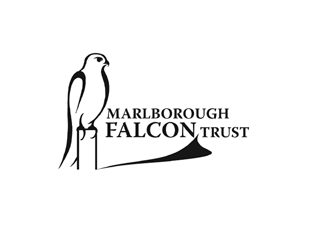 UoC history of falcon research and conservation Dr Nick Fox PhD, Sara Kross PhD
UoC history of falcon research and conservation Dr Nick Fox PhD, Sara Kross PhD
The University of Canterbury (UoC) has a long history of research into kārearea, the NZ falcon. A detailed
study of kārearea in Marlborough by Nick Fox lead to him receiving a PhD from UoC in 1977. In addition
to his thesis Nick wrote a number of papers relating to falcons, including one on the distribution of
kārearea and an estimate of numbers of breeding pairs.
Nick returned to New Zealand to establish the Falcons for Grapes project in 2005. This programme
reintroduced falcons to the Wairau Plains of Marlborough. Sara Kross commenced studying many
aspects relating to this relocation of falcons earning her PhD in 2012 as well as publishing a number of
scientific articles. Sara remains an advisor to the Marlborough Falcon Trust.
MFT Rehabilitation, release where possible and MFT Breeding and release
Kārearea are injured in the wild, sadly some are shot, others suffered electrocution or other injuries. The
Marlborough Falcon Conservation Trust takes care of these birds, they are often x-rayed, checked by a
vet, then housed in large pens in the MFT while they recuperate. The trust retains birds that cannot
safely be released into the wild and where possible for those birds to form mating pairs. Birds that can
be released are, a recent success story is a falcon being trained then released is now a resident on Banks
Peninsular.
Breeding falcons is difficult but the trust has been successful in having four juveniles released last year,
and this season there may be even more from the breeding programme.
Rehabilitation and breeding are very important to aid numbers and understanding of falcons. Advocacy
on hazards to falcons remains the most important focus for the trust as education has potential to have
a greater impact on falcon numbers than breeding. More New Zealanders knowing about and respecting
kārearea as stunning, important members of our fauna will lead to fewer falcons dying unnecessarily.
MFT public viewing, flying, permanent display BEHC
As a threatened species kārearea are held by only a couple of Department of Conservation accredited
organisations in New Zealand. As they are also elusive in the wild they are not often seen by the public.
The Marlborough Falcon Trust has a display aviary at the Brancott Estate Heritage Centre at 180
Brancott Road Marlborough. In addition to having two falcons permanently housed on the site there is
also a flying display that can be booked through the Brancott Estate Heritage Centre.
Wingspan in Rotorua are the only other organisation that has a falcon flying display.
The high speed and amazing agility of kārearea means every audience is stunned by the antics of this
amazing species in flight.
PO Box 566 |Blenheim 7240, Marlborough | New Zealand
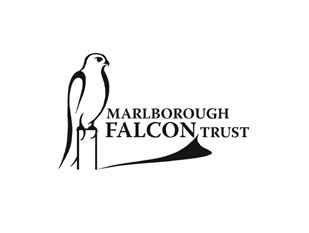 MFT cost of conservation, sponsorship, donations imperative
MFT cost of conservation, sponsorship, donations imperative
The isolation of New Zealand and specifically the absence of land mammals meant the country was
literally a bird paradise before human occupation. The change in the environment with human
settlement, particularly the introduction of mammal predators and habitat destruction has resulted in
extinction of fifty six bird species and many more threatened and at risk. Conservation of taxa at risk is
time consuming, complex and resource intensive. In other words it requires cash!
Building aviaries, release facilities, monitoring, education and research all need financial input. Having
facilities where the public can view threatened species is one very important part of the conservation
effort, the Marlborough Falcon Trust is proud to have excellent facilities at the Brancott Estate Heritage
Centre. In New Zealand sponsorship and donations are critical components of funding conservation
efforts.
Falcon issues: electrocution, shooting, predators, habitat loss
Research and practical experience has highlighted issues for falcon survival in the wild. Fortunately there
are some practical measures that can reduce danger to kārearea. Falcons like to sit high, viewing the
landscape and looking for prey. They sit quietly in trees and also on power poles. Unfortunately for
falcons and other birds the cables on power poles particularly on transformers are sometimes not
insulated and birds can get electrocuted. This can be easily remedied during maintenance or
replacement of the equipment and we have an undertaking by some lines companies to insulate al
potentially hazardous cables in the future. As a transformer has a life of thirty years this hazard will
vanish in some areas in that time, we would welcome a commitment from around the country.
It is distressing to note that kārearea are stil shot whether accidental y or deliberately. Avoiding this is a
primary focus of our education programme.
Falcon adults can be very aggressive, particularly when looking after their eggs or chicks and as adults
they can look after themselves very well. Unfortunately when chicks they can be kil ed by predators such
as stoats or cats, and eggs are even more vulnerable. There is an increasing awareness of the
importance of predator control, including predator proof sanctuaries and ‘halo’ regions in urban areas
near sanctuaries.
Habitat reduction is now less of a factor in falcon survival because the birds are quite widespread and
the natural environment in National Parks and reserves, plus some exotic plantations is suitable for
falcons.
PO Box 566 |Blenheim 7240, Marlborough | New Zealand
Document Outline








